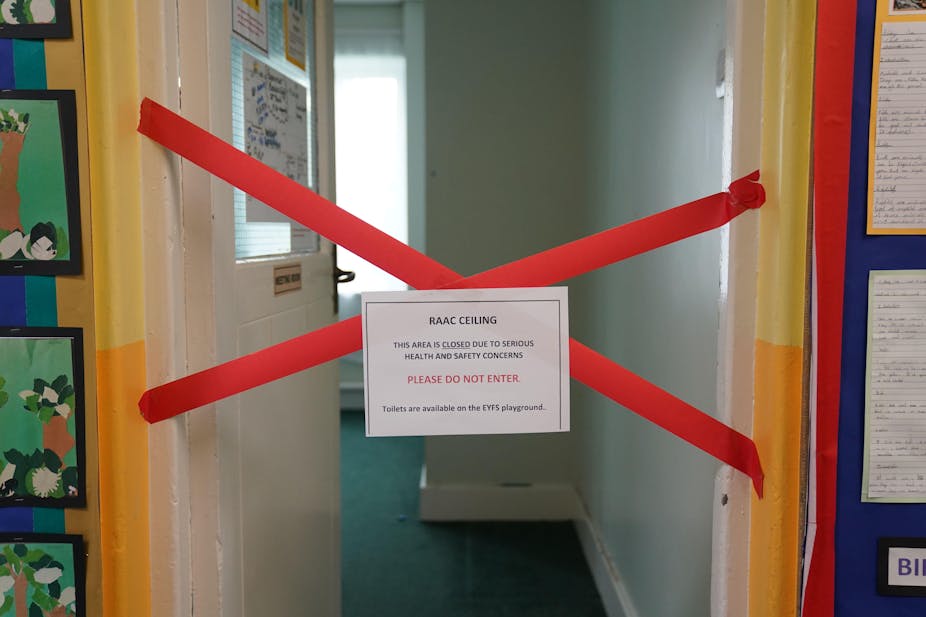More than one hundred schools in England have been fully or partly closed just days before the start of the new academic year, due to concerns over the safety of concrete roof panels.
Problems with what the construction industry terms “reinforced autoclaved aerated concrete” (Raac) were brought to a head in August 2023, when a Raac ceiling panel, that had been deemed safe by inspectors, collapsed at a school in England. In response, the Department for Education issued an urgent alert. More than 156 schools were identified as being at risk.
The British public is understandably sensitive about the safety of building materials and how risk in buildings is managed in the wake of the Grenfell Tower disaster in 2017. The focus here should, specifically, be not on the material itself but on the fact it has been used well beyond its expiry date. Research shows that there are significant risks associated with exceeding the intended design-life of building materials.

Why has Raac been used?
Developed in 1950s and 1960s, Raac – also known as “aircrete” – is an aerated concrete, that is reinforced with steel bars or “rebar”. Air is injected into it during construction, which means it is more than two times lighter than regular concrete (it can even float on water). A cross-section of a slab looks a lot like an Aero chocolate bar.
These characteristic bubbles make the material weaker. But that is not necessarily an issue, since the reduced weight means less strength is required to prevent a panel from bending. Raac panels can easily span up to six metres without an intermediate support column. This suits architectural layouts in many schools, hospitals and other buildings.
Lighter buildings are, in principle, easier to build (and dismantle). They require less materials, which lowers carbon emissions and reduces costs. They are also easier to heat and cool because Raac offers excellent thermal insulation, as compared to bricks or standard concrete.
As a result, Raac has been widely used across the world for decades. It is popular in Turkey and Japan, in particular, due to its excellent performance in earthquakes.
In the UK, it was widely used for floor and wall panels until the beginning of the 1980s, when production was stopped. Other countries, including Germany and the US, continued to produce Raac.
A number of weaknesses were identified from the outset. Raac’s main limitation is that the bubbles and the material composition itself make it vulnerable to moisture and water ingress, especially if there is a leak. This can lead to strength reduction and corrosion of the rebar.
The developers of Raac were well aware of this limitation. Guidelines required that panels be protected from rainwater using asphalt layers. The rebar is also coated to protect against corrosion.
Unfortunately, these protection measures require regular maintenance and inspection. In the UK this hasn’t always happened, due to the associated costs for the building owners.
The protective coating of the rebar can result in reduced grip between the aerated concrete and the steel bars. This can lead to excessive bending and cracking of the panels, which can worsen over time, depending on the temperature.
In the 1990s, this issue was investigated by the building science charity, the Building Research Establishment (BRE), after panels had to be removed from some buildings. The study concluded that no evidence was available at that time to indicate that the Raac panels posed a safety hazard to building users. It said that future inspections and assessments of roofs was needed.

Life of materials exceeded
The BRE study also suggested that the expected design-life of Raac panels was around 30 years. This is less than the 50 years recommended for building structures in the UK. However, building standards in the UK allow replaceable structural parts in buildings to have a lower indicative working life, of between ten and 30 years.
This information was disseminated to schools at that time by the Department for Education. The associated costs for assessment and repairs varied from one school to another. In many cases, budget allocated for monitoring Raac panels was not prioritised.
The sudden Raac roof panel collapse in 2018 at Singlewell Primary School in Gravesend, Kent highlighted additional issues. Subsequent reports, from the standing committee of structural safety (an independent building and civil engineering body in the UK), identified a series of additional construction issues with incorrect positioning of the rebar. Research on building collapses shows that construction defects, which are exacerbated by deterioration, are the most commonly occurring hazard to trigger building failures.
Since then, a number of surveys by, among other bodies, the Institution of Structural Engineers, have highlighted further defects, some of which have led to sudden failures that were difficult to anticipate. The recent panel collapse in August 2023 suggests that this is a systemic issue and that we may have reached a tipping point.
Recent evidence shows that the behaviour of these panels can no longer be predicted reliably due to uncertainties in the material and the mechanical properties of the panels, which are highly impacted by deterioration. This is simply because the panels have been used so far beyond their intended design-life and in many cases without proper maintenance.
Indeed, there is a trade-off between using more durable and expensive materials, which require less maintenance, or using less durable and cheaper materials, that require more costly maintenance. The decision will be influenced by whomever is covering both the initial and the long-term costs. Finding the right balance means considering how a building performs throughout its life-cycle – from construction to operation and demolition or reuse.

